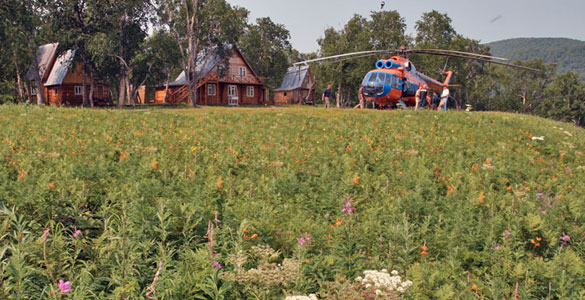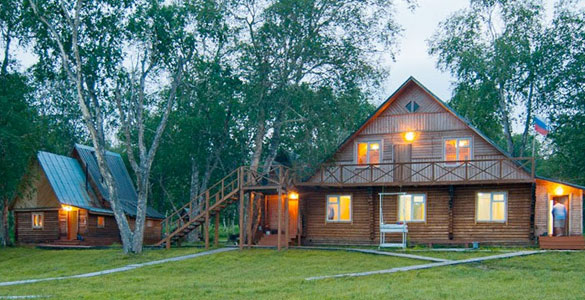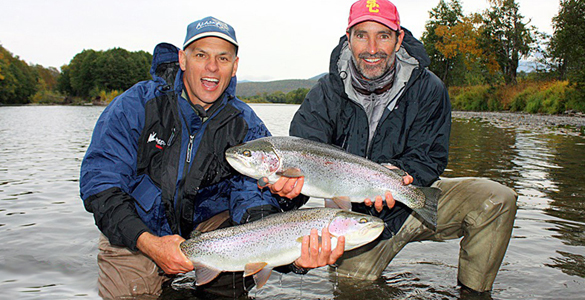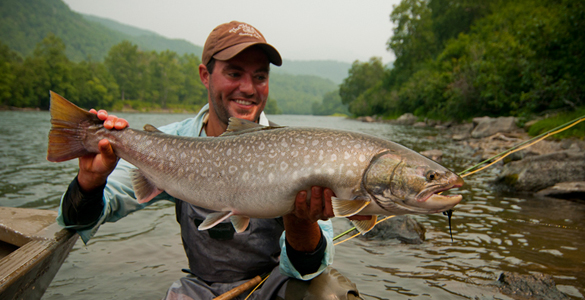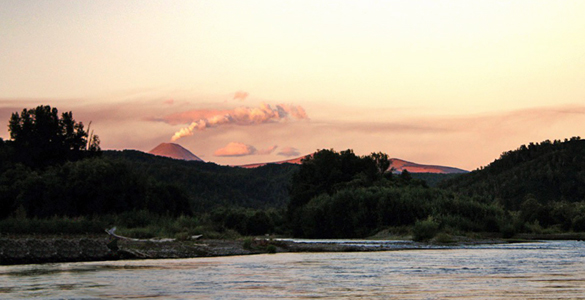Overview
Fly Fishing Kamchatka – Overview

There is only one reason to fish in Kamchatka and that is: fly fishing for very large rainbow trout that eat dry flies all season long! The salmon fishing is also great but the jewels of the fishery are the rainbow trout, throw in trophy char and a new species – Khundza, and you realize a week long fly fishing trip to Kamchatka is way too short.
We specialize in fly fishing trips tfeaturing the best rivers on the penninsula like the Zhupanova and Sedanka. There are certainly more rivers that do offer great trips and we have some exploratory programs if you are wiling to take a chance. Our biggest concern is both the river you fish but as important (in some cases more) is the outfitter you use. This is where we can help. We know all the reliable fly fishing outfitters (both Russian and Western) that run fly fishing expeditions to Kamchatka and can help you choose the right trip and avoid the wrong outfitters.
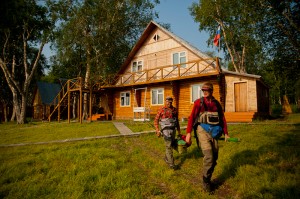
The key to a getting a dependable trip is the combination of American oversight with a well connected partner from Russia. The maze of tricks and who knows who there is mind boggling to us. You need an outfitter who has established these connections with Russian based partners. There are a few Russian only companies that offer fly fishing float trips that are not quite ready for prime time. Even some American led, less established outfitters are having their permits pulled without warning. The trips are expensive and it is not worth taking a chance.
The basic decision starts with what kind of trip you want or are willing to take: A full service fly fishing lodge that uses jet boats to ferry you to the best fishing, A slightly more rustic permanent tent camp (almost a lodge) or to stage float trips from camp to camp hitting a new stretch of water every night.
Your Next Choice- Which River?
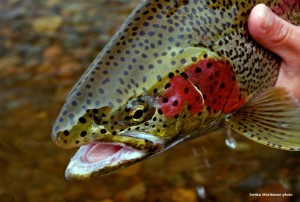
The next choice is a bit harder – do you want lots of solid 18-22″ fish on dries with a few fish each day over 25″ and a few each week at 28+++” or do you want less dry fly action but more streamer action, bigger fish ( 30″ +++) but less of them. No one river has everything so in general the bigger the average of fish is in a river the fewer fish there are. The other issue is how many char are in the rivers? – too many and the rainbow population is smaller.
With the new Air service from Anchorage to Kamchatka most of the outfitters offer 7 day trips or 14 day trips. My job is to help you decide which one is best for you and which ones to avoid. Kamchatka has a lot to offer to the fly fishing enthusiast – fly fishing the way it was in Alaska over 30 years ago is the best way to describe it. Stepping into a river that was off limits during the cold war means a river that has not been fished in 50 years. Russia is the last frontier for freshwater fly fishing for wild, native rainbow trout, steelhead and salmon.
Here are the best fly fishing rivers in Kamchatka – open up the drop downs for the different rivers below.
The Sedanka
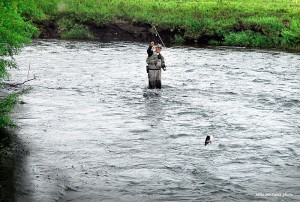 The Sedanka is one of the most remote rivers in Kamchatka. A 3 hour helicopter ride from Petropavlovsk is the only method of access, and once there the river is yours. Just 6 anglers per week share the Sedanka according to our outfitter’s lease terms with the Kamchatka government.
The Sedanka is one of the most remote rivers in Kamchatka. A 3 hour helicopter ride from Petropavlovsk is the only method of access, and once there the river is yours. Just 6 anglers per week share the Sedanka according to our outfitter’s lease terms with the Kamchatka government.
This program is fully guided and involves a combination of traditional walk and wade fishing, float days that utilize inflatable rafts to move downstream, and occasionally jet-motor skiffs are employed to access still more water. All fishing is by wading, with boats merely used as transportation from spot to spot. Because a portion of the week is spent walking and wading, this is the most physically demanding of our Kamchatka trips, though anyone in reasonable shape will be able to take full advantage.
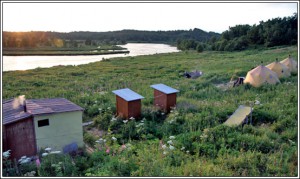
Accommodations are simple and rustic, with double occupancy heated tent cabins, flush toilet outhouses, reliable hot water showers and food that is plentiful and good.
Compared to the other rivers of Kamchatka, the Sedanka stands alone as an immaculate dry-fly fishery with “blow-out proof” clear water. The Sedanka is a float trip that floats between 3 permanent tent camps spending 2 nights at each, flush toilets, hot showers and wood floored double walls tent cabins is pretty darn close to a lodge!
The Zhupanova
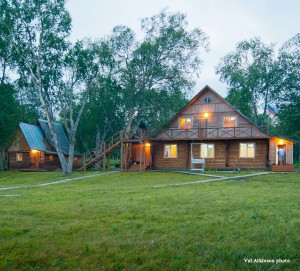
The Only Lodge in Kamchatka
This is the rive that started it all. The Zhupanova. It’s headwaters flow through a massive, immaculate valley framed by smoking volcanoes, snow capped mountains, ancient birch forests, and abundant wildlife. Anglers float 40 miles of the section’s finest fly fishing water to target the Zhupanova’s wild, native huge rainbow trout. Averaging two feet long and commonly reaching 27 – 32 inches or more, they are an exceptionally large and ancient genetic strain. Even more amazing, these river-giants love big skated mouse patterns, reminiscent of waking dry flies for steelhead. And there are endless opportunities to swing streamers on sink-tip lines for vicious, bone-jarring grabs.
Rainbow trout are the main attraction in the Zhupanova but from early August through October, the rare “super kundzha” make their annual run in from the sea. They average 26-28 inches, with exceptional specimens measuring a yard long. Silver (coho) salmon are present during late August and September. The aerobatic fight of a fresh coho is something every angler should experience.
The Zhupanova can be fished from three different types of trips:
The Lodge: The Zendzur Lodge (the only true lodge on Kamchatka) commands 50 miles of water – big water with big fish accessed by jet boats daily.
Zendzur Lodge itself is a beautiful, traditional Russian wilderness outpost, staffed with a combination of talented American and Russian professionals. Lodge amenities are surprisingly deluxe given the remote nature of the operation and include double accommodation suites and cabins, each with private bath and sitting rooms. One of the highlights of Zendzur is the fabulous on-site natural hot-springs, enclosed in a banya cabin just down from the lodge on the riverbank.
THE PROGRAM AT Zendzur utilizes “Alaska-style” 18′ aluminum skiffs, powered by 40hp 4-stroke jet motors. You and one other angler are shuttled from wade-spot to wade-spot by your guide. Most anglers prefer to wade-fish, but for those that prefer to fish from a boat, the guides are very accommodating.
Sample Day:
7 AM: coffee and tea
8 AM: breakfast
9 AM: on the water
1 PM: lunch on the river
6 PM: back to camp for drinks and a soak in the hotsprings.
7 PM: dinner
• For midnight-sun junkies there is a modest sized home pool in front of the lodge.
Zupanova Float trips – float between 6 permanent camps: One Zhupanova float on the upper river incorporates six permanent river camps. Anglers will be able to relax at the end of each day in relative comfort, enjoying hot showers, cold drinks, permanent wood cabins or modern high-tech tents with beds and mattresses, and a well-equipped dining facility. You move to a new camp every day.
The Ichanga
Ichanga Float trips – float with mobile camp: We scheduled two full exploratory adventures in 2013. The first trip landed about 12 miles up this right fork, led 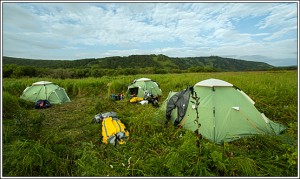 by Mike Michalak and a group of adventurous anglers from Alaska. During the first few days they found a beautiful river cascading through a rugged canyon. Each day they found a few spots holding some really big rainbows, but between each good “hole” was a lot of difficult terrain making access and fishing difficult. Once they left the canyon, however, they found several miles of idyllic water: it was shallow, easily waded, and full of huge rainbows and char.
by Mike Michalak and a group of adventurous anglers from Alaska. During the first few days they found a beautiful river cascading through a rugged canyon. Each day they found a few spots holding some really big rainbows, but between each good “hole” was a lot of difficult terrain making access and fishing difficult. Once they left the canyon, however, they found several miles of idyllic water: it was shallow, easily waded, and full of huge rainbows and char.
Michael Caranci took the second group down the Ichanga a week later, starting at the base of the canyon where the terrain and fishing got really good, spending three days with only 4 anglers exploring every riffle, pocket, boulder, and overhanging tree branch in this small, intimate water. The fishing was incredible, with super aggressive rainbows from 20 to 26 inches attacking streamers and mice patterns with a ferocity not seldom seen in trout.
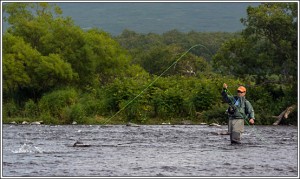 With this first exploratory season under our belts, we knew the quality of the fishery on the Ichanga, and also its limitations. Because it’s a small river, with a short section of perfect trophy trout habitat, we’ve custom built a program around this stream to minimize impacts to the fishery and guarantee a great fishing experience for the few anglers who will have an opportunity to fish it each year.
With this first exploratory season under our belts, we knew the quality of the fishery on the Ichanga, and also its limitations. Because it’s a small river, with a short section of perfect trophy trout habitat, we’ve custom built a program around this stream to minimize impacts to the fishery and guarantee a great fishing experience for the few anglers who will have an opportunity to fish it each year.
Beginning in 2014, the Ichanga will be limited to groups of 4 anglers, focusing 3 days on the Ichanga and ending their week with 2 more full fishing days on the main Savan. To limit pressure on the river and guarantee that it remains as good as we saw it on our first trips down, we will only float and fish it two or three times each summer, with a week or two rest in between trips. This means that literally only 8 or 12 people will have a chance to fish this beautiful stream each year.
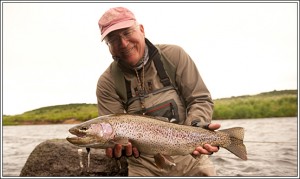 The Ichanga and Savan River floats are set up exactly like our Northern River Wilderness Floats, utilizing hi-tech 4-season mountaineering tents and specialized cooking and camp equipment. A cook and camp assistant travel with the group, preparing tasty meals based on a combination of local fare and more familiar foods. Anglers are responsible only for erecting their two-man tents each day and breaking them down in the morning. Comfortable sleeping pads are provided, but you do have to bring your own sleeping bag and towel. For convenience of communication on the river and for a safety line to the outside world, each expedition is equipped with first aid kits, GPS, handheld radios, and a satellite telephone.
The Ichanga and Savan River floats are set up exactly like our Northern River Wilderness Floats, utilizing hi-tech 4-season mountaineering tents and specialized cooking and camp equipment. A cook and camp assistant travel with the group, preparing tasty meals based on a combination of local fare and more familiar foods. Anglers are responsible only for erecting their two-man tents each day and breaking them down in the morning. Comfortable sleeping pads are provided, but you do have to bring your own sleeping bag and towel. For convenience of communication on the river and for a safety line to the outside world, each expedition is equipped with first aid kits, GPS, handheld radios, and a satellite telephone.
The Savan Base Camp
Savan Base Camp – Jet boats from Fixed Camp:
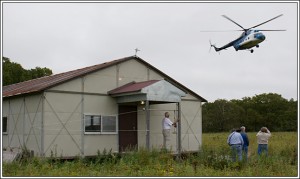 Savan Base Camp is a new enterprise on the Savan River system. For the last 3 years we have been floating the Savan and the Ichanga rivers, finishing our trips at the comfortable base camp. The fishing has been consistently amazing all the way to the takeout, leaving us to wonder what was downstream from the Base Camp. What kind of river monsters lay undisturbed in the lowest reaches of the Savan? This last season we set off to find out, bringing in Jet boats to explore down river and return every night to the comforts of the permanent Base Camp. It could not have been better.
Savan Base Camp is a new enterprise on the Savan River system. For the last 3 years we have been floating the Savan and the Ichanga rivers, finishing our trips at the comfortable base camp. The fishing has been consistently amazing all the way to the takeout, leaving us to wonder what was downstream from the Base Camp. What kind of river monsters lay undisturbed in the lowest reaches of the Savan? This last season we set off to find out, bringing in Jet boats to explore down river and return every night to the comforts of the permanent Base Camp. It could not have been better.
Every year we learn more and discover new secrets on our “NEW” river, the Savan, and this year, by adding the jet boat base camp, we were able to expand our reach to it’s maximum potential on this unbelievable system. Add to that the comfort of staying in the “lodge” all week, with flush toilets and hot showers, and you have Russian trout fishings version of luxury.
IN 2012, WE BEGAN our initial explorations of the river system with two separate week-long wilderness floats scouting out two different sections of the river. What we discovered was a place of awe-inspiring beauty and an incredible diversity of life, both in the water and along its pristine shores. The Savan River system has proven in a short period of time that it is a major contender among Kamchatka’s great trout river’s, with trout averaging 22-26 inches and several fish up to 30 inches hooked each season. At the Savan Base Camp, inflatable Jet Boats are used to access the lower rivers beats, allowing us to cover an amazing amount of excellent water below the Lodge. We still have not explored it all! Wading is relatively easy to moderate for most anglers, but slightly more technical than the upper river. The lower river is bigger water, like in most rivers, and can be deeper and faster in some spots. We tend to fish the softer water, as this is where the fish hide, but we still need to wade over to them, on occasion. There are many stretches of braided water, making the lower Savan feel much smaller than it actually is a lot of the time. Vast rolling mountains and volcanoes flank the broad valley as the river courses it’s way through the wild terrain.
 The lower river we cover is over 15 miles of pristine, untouched water. If you counted every channel of every braid separately, it would have to be way over 60 miles of water, far more than we were able to explore in 2 weeks of fishing with 4 anglers a week. The diversity in this section was also amazing. Different than the upper river, the Lower Savan had big broad runs as well as hundreds of smaller side channels, providing an unbelievably healthy trout habitat, with unique water around every bend. We were ecstatic about the outcome of this first exploratory season, finding a larger average size fish than we had anticipated and plenty of them.
The lower river we cover is over 15 miles of pristine, untouched water. If you counted every channel of every braid separately, it would have to be way over 60 miles of water, far more than we were able to explore in 2 weeks of fishing with 4 anglers a week. The diversity in this section was also amazing. Different than the upper river, the Lower Savan had big broad runs as well as hundreds of smaller side channels, providing an unbelievably healthy trout habitat, with unique water around every bend. We were ecstatic about the outcome of this first exploratory season, finding a larger average size fish than we had anticipated and plenty of them.
A huge part of the diet of the Savan river rainbow trout is eating mice. This is some of the most exciting trout fishing you will ever experience. Fishing with a mouse fly, you get the visual aspect of the surface strike, like in dry fly fishing, and the tight line grab of swinging, giving you the best of both worlds. When conditions change or the mouse bite dies a little, we can cast streamers, swinging across the current, to produce an aggressive take. As a spring creek system, there can also be ideal conditions for aquatic insect hatches. Though dry fly opportunities aren’t common-place, they do happen throughout the season. The season at Savan Base Camp begins in the middle of July, and runs through August. A variety of salmon runs enter the river throughout the season, including king, chum, sockeye, and silver salmon.
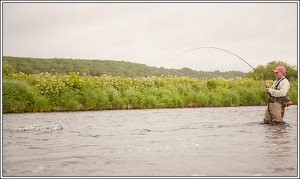 Our Savan River Base Camp is set up exactly like a stationery “lodge”. Everyone will get a double occupancy room in the spacious “Basecamp Lodge”. The lodge has 5 bedrooms and everyone shares an indoor hot shower and flush toilet. We are only taking 4 person groups at the Savan Basecamp in 2015, to insure we are not crowded in the lodge or on the water. A cook and camp assistant are ever present at Base Camp, preparing hearty meals based on local Russian fare. Anglers are responsible only for opening a beer at the end of a long day of fishing, and the guys will even do that for you, if you ask nicely. Comfortable beds with mattresses are provided, with a comforter and pillow, but we suggest you you do bring your own sleeping bag and towel. For convenience of communication on the river and for a safety line to the outside world, Savan Base Camp is equipped with first aid kits, GPS, handheld radios, and a satellite telephone.
Our Savan River Base Camp is set up exactly like a stationery “lodge”. Everyone will get a double occupancy room in the spacious “Basecamp Lodge”. The lodge has 5 bedrooms and everyone shares an indoor hot shower and flush toilet. We are only taking 4 person groups at the Savan Basecamp in 2015, to insure we are not crowded in the lodge or on the water. A cook and camp assistant are ever present at Base Camp, preparing hearty meals based on local Russian fare. Anglers are responsible only for opening a beer at the end of a long day of fishing, and the guys will even do that for you, if you ask nicely. Comfortable beds with mattresses are provided, with a comforter and pillow, but we suggest you you do bring your own sleeping bag and towel. For convenience of communication on the river and for a safety line to the outside world, Savan Base Camp is equipped with first aid kits, GPS, handheld radios, and a satellite telephone.
These expeditions are organized to be flexible based on the conditions, the group, and the nature of the fishing. This is the beauty of a jet boat camp, being able to be flexible and go to where we think it will be best. There are several sections of braided river where we may spend multiple days exploring the many channels. Other sections may be fished quickly, covering the water, looking for the types of water that consistently hold the Savan’s massive resident rainbows. The jet boats are used exclusively for transportation, with all of the fishing being done on foot, wading.
Savan Float Trips
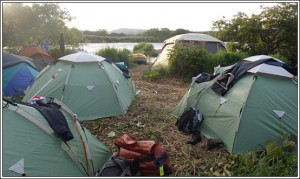 Savan Float trips – float with mobile camps: IN 2012, WE BEGAN our initial explorations of the river system with two separate week-long wilderness floats scouting out two different sections of the river. What we discovered was a place of awe-inspiring beauty and an incredible diversity of life, both in the water and along its pristine shores.
Savan Float trips – float with mobile camps: IN 2012, WE BEGAN our initial explorations of the river system with two separate week-long wilderness floats scouting out two different sections of the river. What we discovered was a place of awe-inspiring beauty and an incredible diversity of life, both in the water and along its pristine shores.
The Savan River system shows the sort of promise that we first saw on the Zhupanova in the mid 1990s, with trout averaging 22-26 inches and several fish up to 30 inches hooked each season. It is a spring creek system, similar to Sedanka in its crystal clear flows and vibrant ecosystem. The Savan is easily floated and the wading is simple, mostly flat, shallow and wide with a pumice and gravel bottom strewn with a few obvious boulders. Overall the terrain is gradual, making getting around a breeze. Vast rolling mountains and volcanoes flank the broad valley it courses through, and partway down the river is a system of idyllic hot springs, perfect for midweek relaxing and soaking.
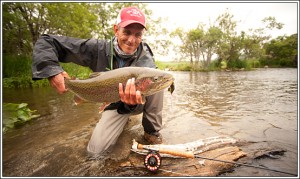 The river runs for over 70 miles, and features countless springs and one major tributary. In 2013, we continued our exploration of the river system over the course of a 5 week season, pinpointing the most productive sections, the most idyllic camp sites, and the best landing zones. We continued to investigate this remarkable angling paradise in 2014 with a 6 week season, with boatloads of happy anglers and more photos of trophy rainbows than we know what to do with.
The river runs for over 70 miles, and features countless springs and one major tributary. In 2013, we continued our exploration of the river system over the course of a 5 week season, pinpointing the most productive sections, the most idyllic camp sites, and the best landing zones. We continued to investigate this remarkable angling paradise in 2014 with a 6 week season, with boatloads of happy anglers and more photos of trophy rainbows than we know what to do with.
Fish readily take streamers swinging across the current, and as with other rivers in Kamchatka a mouse will almost always produce an aggressive take. As a spring creek system, there are ideal conditions for aquatic insect hatches, too, though dry fly opportunities aren’t common-place, they do happen throughout the season.
The season at Savan and Ichanga begins in the middle of July, and runs through August. A
variety of salmon runs enter the river throughout the season, including king, chum, sockeye, and silver salmon. Because it is a spring-fed system, the river is always clear, and always wade-able.
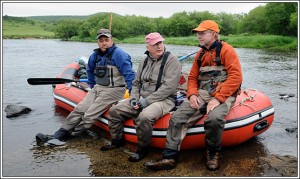 Our Savan River floats are set up exactly like our Alaska Floats, utilizing hi-tech 4-season mountaineering tents and specialized cooking and camp equipment. A cook and camp assistant travel with the group, preparing tasty meals based on a combination of local fare and more familiar foods. Anglers are responsible only for erecting their two-man tents each day and breaking them down in the morning. Comfortable sleeping pads are provided, but you do have to bring your own sleeping bag and towel. For convenience of communication on the river and for a safety line to the outside world, each expedition is equipped with first aid kits, GPS, handheld radios, and a satellite telephone.
Our Savan River floats are set up exactly like our Alaska Floats, utilizing hi-tech 4-season mountaineering tents and specialized cooking and camp equipment. A cook and camp assistant travel with the group, preparing tasty meals based on a combination of local fare and more familiar foods. Anglers are responsible only for erecting their two-man tents each day and breaking them down in the morning. Comfortable sleeping pads are provided, but you do have to bring your own sleeping bag and towel. For convenience of communication on the river and for a safety line to the outside world, each expedition is equipped with first aid kits, GPS, handheld radios, and a satellite telephone.
These expeditions are organized to be flexible based on the exploratory nature of the fishing. There are several sections of braided river where we may stay in camp for multiple days to explore the multiple channels on food from a home base. Other sections may be fished quickly, covering 10-15 miles of water in a day to focus on the types of water we find that consistently hold the Savan’s massive resident rainbows. The boats are used exclusively for transportation, with all of the fishing done on foot.
Unexplored Float Trips
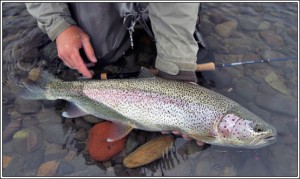 Kamchatka is the last frontier of unexplored, wilderness fly fishing. For truly adventurous souls, an exploratory expedition to one of Kamchatka’s virgin trout rivers will be the holy grail of fishing trips.
Kamchatka is the last frontier of unexplored, wilderness fly fishing. For truly adventurous souls, an exploratory expedition to one of Kamchatka’s virgin trout rivers will be the holy grail of fishing trips.
We’ve had great luck finding stellar fishing on our exploratories because the rivers we choose are not picked willy-nilly. They are carefully selected based on the best available scientific and local anecdotal knowledge, gathered and honed by The Fly Shop staff over the course of 13 years fishing and exploring on the Kamchatka Peninsula. But our pre-trip preparations go even further than that: We attempt as much helicopter reconnaissance of the drainage as is possible to reduce the potential of setting down on a log-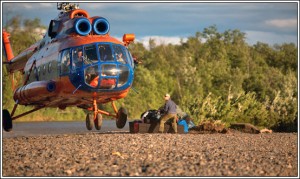 jammed, flooded, or otherwise impossible-to-fish river. We are interested only in systems that exhibit the highest potential for world-class rainbow trout fishing, stable water conditions, and floatability.
jammed, flooded, or otherwise impossible-to-fish river. We are interested only in systems that exhibit the highest potential for world-class rainbow trout fishing, stable water conditions, and floatability.
All that being said, these trips are definitely not for everyone. In order to be a candidate for an exploratory expedition, you need to be physically and mentally prepared for the host of uncertainties that come with stepping into the unknown. Whether it’s chipping in with an axe to cut out log jams, flattening a boulder-bar to pitch a tent, or humping gear to and from the chopper or around un-navigable water, you need to be prepared to burn a few hours or a half-day of fishing here and there if the situation requires it. But hey, you never know, chopping though that log jam may be the ticket to trout nirvana. It’s happened before!
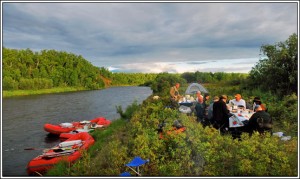 Maybe you’ve had a day or two in Alaska, Canada, Patagonia, or even the remote Rocky Mountains, where everything is perfect – the crowds are gone, your surroundings are mind-blowingly beautiful and the fishing is hot. Now imagine a day where on top of that, no one else has ever fished the river you are standing in.
Maybe you’ve had a day or two in Alaska, Canada, Patagonia, or even the remote Rocky Mountains, where everything is perfect – the crowds are gone, your surroundings are mind-blowingly beautiful and the fishing is hot. Now imagine a day where on top of that, no one else has ever fished the river you are standing in.
These are not once-in-a-lifetime trips; these are once-in-history trips.
Lodging
Lodging or Camping When Fly fishing Kamchatka?
Here is a summary of the types of accommodations you wil find while fly fishing Kamchatka.
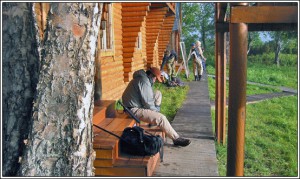
The only lodge in Kamchatka is the Zendzur
Zendzur Lodge is the only full fledged lodge on Kamchatka. It is a well crafted outpost that features all the luxuries of any remote fishing lodge. On the edge of the forest it is staffed by a combination of Russian and American guides, cooks and staff. The accommodations are double suites and cabins with private bathrooms, hot showers and a sitting room. The hot springs are a bonus to a long day on the river.
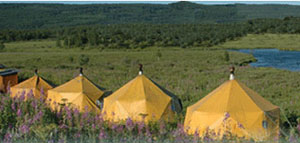
a tent camp on the Sedanka
There are three camps on the Sedanka, spread about 10 river miles apart from one another. Over the course the 6 day trip, anglers move between all three camps via inflatable rafts.
Each camp is identical in infrastructure. Two anglers share a high-tech, weatherproof, double-walled “tent cabin,” similar to the weather-port cabins in use in many Alaskan camps. They have wood floors, high ceilings, a wood stove for heat, bed frames and mattresses. (You must bring a sleeping bag for this trip.) There are two clean flush-toilet outhouses per camp, as well as multiple shower facilities with good water pressure and endless hot water, courtesy of an ingenious Russian wood-fired plumbing system.
The kitchen and dining rooms are permanent log cabins, built long ago as trappers’ shelters. All camp infrastructure is connected by extensive wooden walkways.
 The mobile tent float trips and wilderness trips are done just like our alaska float trips with smaller tents that are put up and taken down each day in a different spot – there is also a dining and cook tent that travels with the group each day
The mobile tent float trips and wilderness trips are done just like our alaska float trips with smaller tents that are put up and taken down each day in a different spot – there is also a dining and cook tent that travels with the group each day
Naturally the mobile camps give the mst flexibility in that you can travel slowly or quicky depending on the fishing you encounter and they are on the smaller less explored rivers where groups of 4-6 are allowed 3-4 times a year…amazing!
 The Savan Base Camp is permanent structure ad is more primitive than the Zendur lodge. It is equipped with private bedrooms with a shared shower and a shared toilet room. The dining and lounge is in the same building
The Savan Base Camp is permanent structure ad is more primitive than the Zendur lodge. It is equipped with private bedrooms with a shared shower and a shared toilet room. The dining and lounge is in the same building
Camp/Lodge Photos
Mike’s Zhupanova Trip
Mike’s Sedanka Trip
Fishing
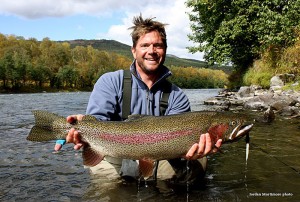 There is one good reason to travel all the way to Kamchatka to fish. It is large, wild rainbows that love dry flies. Fly fishing on Kamchatka is the last true wilderness where trout remain in the original condition. Millions of years ago rainbows migrated to our coast from this area.of Russia. This is where rainbows developed and they are perfectly suited of the environment here. Take Alaska, double the number of fish and subtract all the fishermen and women and you start to get an idea of what it is like. Like Alaska though it is not every stream that is perfectly suited for these fish. The rivers we fish are on both the west coast and the east coast of the Kamchatka peninsula. The water runs clear all season regardless of rainfall. The endless supply of insects is what makes this so much different than Alaska. Insects are hatching all season long hatch all year round and the bows will almost never refuse a large caddis as it skates across the surface. If you are looking for a place where presentation is everything go somewhere else.
There is one good reason to travel all the way to Kamchatka to fish. It is large, wild rainbows that love dry flies. Fly fishing on Kamchatka is the last true wilderness where trout remain in the original condition. Millions of years ago rainbows migrated to our coast from this area.of Russia. This is where rainbows developed and they are perfectly suited of the environment here. Take Alaska, double the number of fish and subtract all the fishermen and women and you start to get an idea of what it is like. Like Alaska though it is not every stream that is perfectly suited for these fish. The rivers we fish are on both the west coast and the east coast of the Kamchatka peninsula. The water runs clear all season regardless of rainfall. The endless supply of insects is what makes this so much different than Alaska. Insects are hatching all season long hatch all year round and the bows will almost never refuse a large caddis as it skates across the surface. If you are looking for a place where presentation is everything go somewhere else.
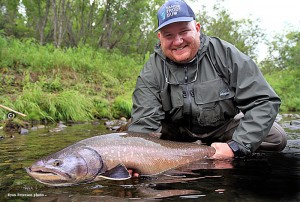 If you want lots of 24″ rainbows on the surface with most of the flies in your box come visit. The fish in the rivers we choose to fish are filled with rainbow and char with Pacific Salmon as well. Some rivers have mostly char while others have mostly rainbows. The rivers we choose have tons of rainbows and tons of char. Most of the rainbows are a true 18-25″ and 3-8 pounds. Each season we land some genuine 30-35″ fish!
If you want lots of 24″ rainbows on the surface with most of the flies in your box come visit. The fish in the rivers we choose to fish are filled with rainbow and char with Pacific Salmon as well. Some rivers have mostly char while others have mostly rainbows. The rivers we choose have tons of rainbows and tons of char. Most of the rainbows are a true 18-25″ and 3-8 pounds. Each season we land some genuine 30-35″ fish!
Whether you decide on a lodge, or a float trip the fishing is pretty much the same (Great!). We wade the rivers for the most part and use the jet boat or raft to travel to a new section. The rivers are generally easy to wade gravel bottom that run clear year round.large river a bit harder to wade with great runs of salmon and of course very large rainbows. Every run that looks like it has fish does. You  can cross the river in lots of areas, it is perfect fly fishing terrain. The lodge guests will usually fish between within 15 miles up or down from the lodge. Since there are 8 guests at the lodges that have have exclusive use of the entire river the fish are aggressive and stupid. In fact that much river with so few anglers add up to a mile of water for every client that visits all season long. This low pressure is obvious. The fish will eat just about anything. Come join us in Fly fishing Heaven Russian style!
can cross the river in lots of areas, it is perfect fly fishing terrain. The lodge guests will usually fish between within 15 miles up or down from the lodge. Since there are 8 guests at the lodges that have have exclusive use of the entire river the fish are aggressive and stupid. In fact that much river with so few anglers add up to a mile of water for every client that visits all season long. This low pressure is obvious. The fish will eat just about anything. Come join us in Fly fishing Heaven Russian style!
Kamchatka Fly Fishing Methods
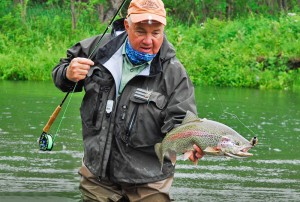
Mouse: Real mice slip and fall into the river from overhanging limbs and grass and then swim like a cork at a down-and-across angle. As they swim, they throw small V-wake contrails off their back end which the trout key to. Anglers replicate this action by plopping their flies against the opposite bank and skittering them across the river, on tension and under control. What follows has got to be the most exciting thing in freshwater fly fishing. Since a live mouse in the stomach of a rainbow trout can do some damage, they tend to take the fly with a ferocious, bone-crushing chomp with the intention of killing the mouse before they swallow it. This behavior is obviously on the surface, totally visible to you. The skill comes in controlling your nerves trying NOT to set the hook when the fish merely swirls behind it – sometime 2, 3, 4 or more times – before actually committing.
Dry Fly: Traditional floating line and size #10-18 gray bodied caddis and mayfly imitations are used with staggering success on KamchataRivers, especially in July, less so in August, and again quite successfully in September. The fish tend not to be picky on the specific pattern. However, with so much food floating past their 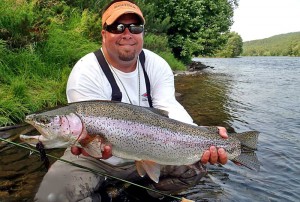 feeding lies, it is sometimes critical to deliver a reasonably accurate and truly dead drifted presentation. If the fly floats within an inch or so of the trout’s nose the chances of it rising are very good.
feeding lies, it is sometimes critical to deliver a reasonably accurate and truly dead drifted presentation. If the fly floats within an inch or so of the trout’s nose the chances of it rising are very good.
Streamer: Salmon smolt and other juvenile fish make up a significant portion of Kamchatka trout and chars’ diets. Clousers, woolly buggers, string leeches, baitfish and sculpin patterns all work very well on the Sedanka throughout the season. Small fish elicit a chase response from their predators, so often it is best to give the fly a little movement as it swings through the water column. And like with the mouse, it’s best to learn to identify likely structure in the river (tree roots, riffle-pools, rocks, undercut banks, etc.) that offer rest areas for the fish adjacent to heavier currents where they can surprise-attack their food.
Kamchatka Fishing Photo Gallery
Tackle & Gear
Here is a list of the basics you will need for your trip. Many of our destinations are pretty remote with no chance to buy things on site.
[table id=154 /]
Fly List
[table id=155 /]
Packing List
[table id=156 /]
Rates
Kamchatka Fly Fishing Trip Prices
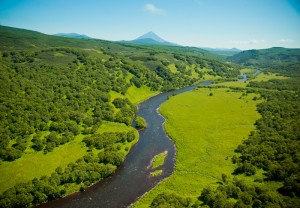
Zendur Lodge trip $6695
Permanent tent camp trips:
Sedanka River- $7850
Zhupanova River Lodge – $6995
Zhupanova River Float – $6995
Savan River Float or Base Camp – $6850
Ichanga River Float – $6850
Wilderness Float trips – $7395 (6 nights) $11995 (12 Night combo with Sedanka Trip)
Trip length is 6 nights with 6 days of fishing*
*2 trips can be combined to make a 13 night trip with 12 days of fishing
Much of the cost of a trip is the helicopter charters, not the type or quality of the trip! If a river is 50 miles further away it will cost much more to get there. Float planes would be less expensive but these rivers just don’t have lakes at either end to drop off and pick up.
Sample Itinerary:
Friday: Travel from home to Anchorage
The day before departure to Kamchatka, you’ll need to arrive in Anchorage, AK and overnight.
Saturday: Depart Anchorage on Yakutia Air
Departure on Yakutia Air is early in the morning. Check in usually opens around 5:30 a.m. and it is advised you arrive then, two hours before flight time. Other passengers on this flight often consist of volcanologists, rafters, hunters, miners and others who travel with a lot of oversized equipment. The check-in procedure can take some time. Better to be there as early as possible. The flight lasts about 4.5 hours, and crosses the International Dateline. You arrive to Kamchatka on Sunday morning.
Sunday Morning: Arrival to Petropavlovsk, transfer to camp
Arrival is at 9:00 a.m. After passing through customs and immigration, fishermen collect luggage and are greeted by the Savan ground staff. Once everyone is through customs, you will be transported along with your luggage to Martha’s guesthouse, where she will ask for your passports to make copies to fill out the paperwork that will be required for departure from Russia at the end of your trip.
The first few hours in Kamchatka are always an exercise in patience. Understand that this is Russia, and communication from the helicopter companies is often lackluster at best. Keep in mind that the outfitters want you to get into camp as much as you do, and they are often at the whim of the helicopter companies. The helicopter companies don’t get paid unless they fly, so their priority, too, is to get you into camp… safely. Mornings in Petropavlovsk are frequently foggy, and the helicopters cannot fly until the fog clears. If the weather is clear in the morning, you will head straight to the heliport. If not, you will have the option to relax at Martha’s guest house, or walk to the nearby Old Castle Restaurant, which has very good food (and local draught beer, Kamchatksi #1).
As soon as the fog lifts and the pilots give weather clearance, everyone will board the van for the 30 minute drive to the heliport on
the outskirts of Yelisovo. Once there, you will load your bags onto the Mi8 helicopter and lift off for BaseCamp. The helicopter flight from Yelisovo lasts for about 50 minutes, and is often one of many highlights from the trip. Sometimes head sets are provided, but this is Russia and you never know so it is recommended that you bring some earplugs for the noise of the rotors. The flight will take you over countless rivers and streams, and past several volcanoes.
Upon arrival at Base Camp: Basecamp is a hunting lodge nestled in a clearing a short stroll from the lower Savan River. Guests will disembark the helicopter and unload all of their gear. Be sure to collect all of your bags and keep an eye on them, as the helicopter will quickly be reloaded with the equipment, gear, food, and the other groups luggage heading to the main Savan float. You will then, along with the guides and staff, move into your room at the Base Camp Lodge. The other group will reload the helicopter for a short flight upriver to the first camp on the Savan float.
Next Sunday: Returning home
After a leisurely breakfast in the morning, guests have time to dry clothes and waders, re-pack their bags, and prepare for the trip home. The helicopter will arrive sometime between 11:00 am and 4:00 pm (depending on weather clearance), and will transfer you back to Petropavlovsk in time to catch the 8 p.m. flight back to Anchorage. If you return to Yelisovo early in the day, Vadim will meet you again and transfer you to Martha’s guest house to wait. There is a very good restaurant (Old Castle Restaurant) a 15 minute walk from Martha’s. If there is time, the bus can also take the group to a nearby store for souvenir shopping. Martha will get everyone the departure paperwork at this time, which you will need to present along with your passport and visa at immigrations before boarding the flight home.
The flight lasts about 4.5 hours. Although you depart Russia on Saturday evening, you also cross the dateline again, thereby arriving in Alaska at 5:55 a.m…on Saturday morning!. Customs and immigrations in Anchorage is very quick and easy, and you’ll have the whole day to connect back home, or to other fishing in Alaska.
Prices include: All ground and Helicopter transfers in Russia, one night in a hotel in Petropavlovsk if needed, all lodging, meals, guided fishing, soft drinks, Prices quoted are per person and in US dollars.
Prices do not include: Airfare from point of origin to Petropavlovsk, alcoholic beverages, tips , visa fees or travel/medical insurance.
Why Book Through Flyfishingheaven.com?
Why book through flyfishingheaven.com?
[table id=108 /]
Our Pledge
[table id=93 /]
Payment and Cancelation Polices
[table id=107 /]
Seasons
Fly Fishing Kamchatka Seasons

Unlike in other parts of the world, the number and size of rainbows you’re likely to hook on a given day in Kamchatka is not seasonally dependent. Instead, picking a specific week to visit Kamchatka should be based on your preferences for weather, the different methods used during July, August and September, and whether or not you are interested in a variety of species or only rainbow trout.
July is the warmest month of the year in Kamchatka and typically has the most reliable weather, with daytime temperatures between 60 and 80 degrees. Rain and 50 degree days, however, can happen any time of the year. Mouse and streamer fishing is consistent in most rivers an streams from the beginning to the end of the summer. Perhaps the best dry fly fishing is in July when mayfly and caddis hatches are at their heaviest. In fact, there is no rivers in the world where a larger river-resident, native rainbow can be caught on a caddis pattern! There are no salmon in the rivers at this time, but sea-run Dolly Varden do show up toward the end of the month. By the last week of July the famous “Super Kundzha,” a sea-run char species found only in the Zhupanova River, begin to pour in from the sea. They are big, powerful fish that take the fly well and put up a fight comparable to a king salmon or steelhead. If you have a low mosquito tolerance level, consider a trip later in the season.
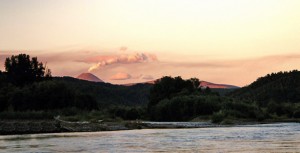 August is the middle of the season. Chum and sockeye salmon enter the rivers and the cycle of life is laid out in full magnificence. Rainbows are targeted with mouse and streamer flies throughout the month. The first two weeks of August, too, are the peak time to intercept the Super Kundzha (on the Zhup). By the middle of the month the mosquitoes, black flies and no-see-ums are completely gone and the weather transitions toward fall.
August is the middle of the season. Chum and sockeye salmon enter the rivers and the cycle of life is laid out in full magnificence. Rainbows are targeted with mouse and streamer flies throughout the month. The first two weeks of August, too, are the peak time to intercept the Super Kundzha (on the Zhup). By the middle of the month the mosquitoes, black flies and no-see-ums are completely gone and the weather transitions toward fall.
September is fall in Kamchatka. It can be chilly, in the 50-degree range. Sunny weather (which is quite common) makes for beautiful fishing days, but brings with it frosty nights. It is also the most photogenic time of year to be amid the sub-arctic taiga and tundra foliage as it turns to blazing yellows, reds and oranges with a backdrop of snow-capped volcanoes. Trout are taken with dry flies, surface skaters,mice patterns and with “big nasty” leeches and baitfish patterns. The latter, fished on a sink-tip line, become more important as water temperatures drop.
Gallery
Please take a look at the photo and video galleries related to fly fishing Kamchatka.
Fly Fishing Kamchatka Photo Gallery
no images were found
Camp/Lodge Photo Gallery
Kamchatka Scenery Photo Gallery
Kamchatka Video Gallery
Activities
Non-Fishing Activities
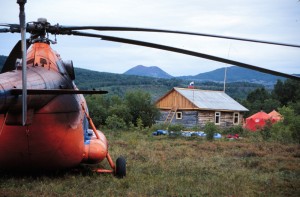
Well, like Alaska there is not much to do on these fly fishing Kamchatka trips except fish. I suppose if you have a wife or family member who is an avid wildlife photographer and didn’t mind some mosquitoes or a little rain, they would enjoy it as well. It is a great culture but much of this trip gets you out of the culture except for the guides and staff around you. Please think twice before inviting that non fishing spouse of yours be they male or female.
Travel
Travel Information About Kamchatka
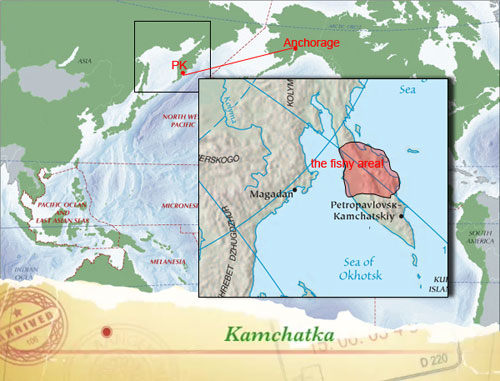
Air Travel – We use Red Star travel in Seattle to help book all flights and help get visas for all guests. Starting in 2012, getting to Kamchatka is a snap. With Vladivostok Air’s renewed service between Anchorage, Alaska and Petropavlovsk-Kamchatka, Russia’s most pristine, bountiful trout streams are just a few hours from breakfast in the United States. you could still fly through Moscow if you planned on touring other areas of Russia.
Visas: Not an easy process, you must have it, you must pay for it and we will help you get it. If you booked your flight through Red Star they will pay your visa invitation fee($50) In order to get a visa you must send/bring your passport to a Russian Embassy. Red Star will hand carry your passport to teh local embassy in Seattle. The visa fee is $250.
Hotel in Anchorage: We recommend getting your motel reservations as soon as possible. The motels get booked up in the summer. We recommend the Best Western Barratt Inn, 1-800-221-7550 or (907) 243-3131 or, the Millennium Alaskan Hotel 800-544-0553 and 907-243-2300 or, try the Courtyard Marriott Anchorage Airport 1 800-314-0782 or 1 907-245-0322. They all offer free 24-hour shuttle service to and from the airport, and have storage for your suitcases while you are on the river.
Travel Insurance: These trips require trip insurance and medical evac insurance is required by the Russian Government. We recommend Travel Guard. This includes medical insurance good in Russia, trip cancellation insurance and emergency medical transportation in case of a medical emergency.
Phones: American cell phones worked in Kamchatka last summer! Last year we could bring satellite phones into Kamchatka. Things change from year to year in Russia so please do not take this as the last word.
A Sample Itinerary
Typical itineraries have anglers arriving to Anchorage on a Wednesday, overnighting, and hopping the 4 hour flight to Kamchatka on Thursday morning. While in the air over the middle of the Bering Sea, the airplane crosses the International Dateline, arriving to Petropavlovsk-Kamchatsky on Friday morning at 9 a.m. From there, an immediate ground transfer and helicopter flight brings anglers into camp, deep in the wilderness. On the return leg, departure from Kamchatka is at 8 p.m. on Thursdays. Crossing the dateline again, arrival back to Anchorage is at 4:10 a.m., also on Thursday. This leaves the rest of the day to continue home.
Anglers bound for Kamchatka may also realize that side trips in Alaska are easily linked to the Vladivostok Air schedule in/out of Anchorage.
Sample itinerary for one week Kamchatka Trip:
(8 nights away from home – 5.5 days fishing)
• Wednesday – travel to Anchorage, overnight
• Thursday – Depart ANC 6:00 a.m.
• Friday – 4-hour flight. Cross int’l dateline. Arrive Kamchatka 9:00 a.m. Helicopter to river. 1/2 day fishing.
• Saturday – Fishing
• Sunday – Fishing
• Monday – Fishing
• Tuesday – Fishing
• Wednesday – Fishing
• Thursday – Depart camp midday. Flight departs 8:00 p.m. Arrive Anchorage 4:10 a.m. Spend time in Alaska, or continue home.
Packing List
[table id=156 /]

